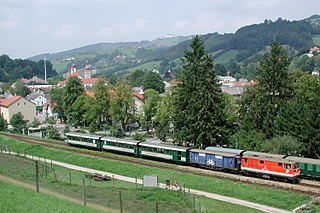
The Deutsche Reichsbahn, also known as the German National Railway, the German State Railway, German Reich Railway, and the German Imperial Railway, was the German national railway system created after the end of World War I from the regional railways of the individual states of the German Empire. The Deutsche Reichsbahn has been described as "the largest enterprise in the capitalist world in the years between 1920 and 1932", nevertheless its importance "arises primarily from the fact that the Reichsbahn was at the center of events in a period of great turmoil in German history".

The Mariazell Railway is an electrically operated narrow-gauge railway which connects the Lower Austrian capital of Sankt Pölten with the Styrian pilgrimage centre of Mariazell. The line was opened in stages between 1898 and 1907, and had a, now closed, branch to Wieselburg an der Erlauf. The railway is operated by NÖVOG, which is owned by the provincial government, and is a part of the Verkehrsverbund Niederösterreich-Burgenland.

The South African Railways Class NG15 2-8-2 is a class of narrow-gauge steam locomotive.
Under the Whyte notation for the classification of steam locomotives by wheel arrangement, a 4-8-2+2-8-4 is a Garratt articulated locomotive consisting of a pair of 4-8-2 engine units back to back, with the boiler and cab suspended between them. The 4-8-2 wheel arrangement has four leading wheels on two axles, usually in a leading bogie, eight powered and coupled driving wheels on four axles and two trailing wheels on one axle, usually in a trailing truck. Since the 4-8-2 type is generally known as a Mountain, the corresponding Garratt type is usually known as a Double Mountain.

Under the Whyte notation for the classification of steam locomotives by wheel arrangement, 2-6-2+2-6-2 is an articulated locomotive using a pair of 2-6-2 power units back to back, with the boiler and cab suspended between them. The 2-6-2 wheel arrangement has a single pair of leading wheels in a leading truck, followed by three coupled pairs of driving wheels and a pair of trailing wheels in a trailing truck. Since the 2-6-2 type was often called the Prairie type, the corresponding Garratt and Modified Fairlie types were usually known as a Double Prairie.
The Tramway de Pithiviers à Toury (TPT) was a 600 mm narrow gauge railway in the Loiret department of France. The system had a total extent of 80 kilometres (50 mi)

The Steyr Valley Railway was a 760 mm narrow gauge railway in Upper Austria, which ran along the valley of the River Steyr from Garsten through Steyr, Grünburg and Molln to Klaus, with a branchline to Sierning and Bad Hall. A section of the line has been retained as a museum railway.

The Ybbs Valley Railway was a narrow-gauge railway of the Austrian Federal Railways with a track gauge of 760 mm, located in the Lower Austrian Mostviertel.

The Lower Austrian Höllental Railway is a narrow gauge electric railway with a track gauge of 760 mm, which runs from the Austrian Federal Railways (ÖBB) station of Payerbach Reichenau on the Semmering Railway for approximately five kilometres through the market town of Reichenau an der Rax to Hirschwang.

The Murtalbahn is a 760 mm narrow-gauge railway largely located in the state of Styria in Austria. The line runs along the valley of the River Mur from the market town of Unzmarkt through Murau to Tamsweg, which is just over the Styrian border in the state of Salzburg. The railway is operated by Steiermärkische Landesbahnen and, with a total length of 76.1 km (47.3 mi), it is the fourth-longest narrow-gauge railway in Austria.

The Taurach Railway is a 760 mm narrow-gauge museum railway in the Austrian state of Salzburg.

The Thörlerbahn was a 760 mm gauge narrow-gauge railway, operated by the Steiermärkische Landesbahnen between Kapfenberg and Au-Seewiesen in Austria. It connected the region around Aflenz in the Obersteiermark with the southern main line at Kapfenberg.

The steam locomotives of Südbahn Class 23 (old) were goods train engines worked by the Austrian Southern Railway.
A Heeresfeldbahnlokomotive is the German term for a special wartime locomotive (Kriegslokomotive) for employment on military field railways (Heeresfeldbahnen), railways usually designed to transport military supplies to the front line.

A forest railway, forest tram, timber line, logging railway or logging railroad is a mode of railway transport which is used for forestry tasks, primarily the transportation of felled logs to sawmills or railway stations.

A steam railcar is a railcar that is self powered by a steam engine. The first steam railcar was an experimental unit designed and built in 1847 by James Samuel and William Bridges Adams in Britain. In 1848 they made the Fairfield steam carriage that they sold to the Bristol & Exeter Railway, who used it for two years on a branch line.
The Chemin de fer à vapeur des Trois Vallées is a heritage railway in southern Belgium, created in 1973.

The BBÖ 478 was a class of fifty 0-8-0T shunting locomotives of the Bundesbahnen Österreich (BBÖ).

The BBÖ 729 was a class of 26 Austrian 4-6-4T locomotives designed to haul fast passenger trains for the Federal Railway of Austria.

















